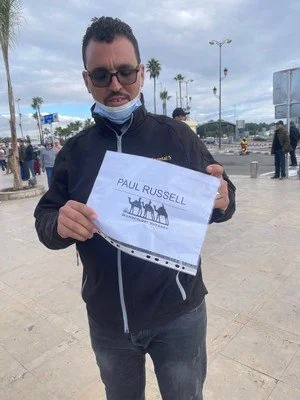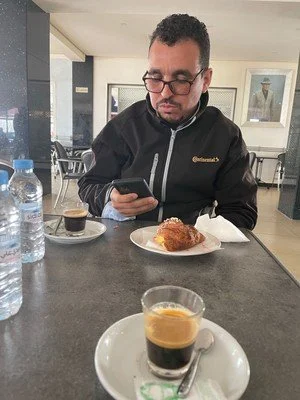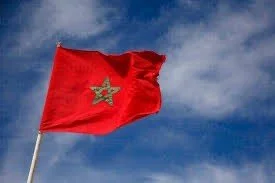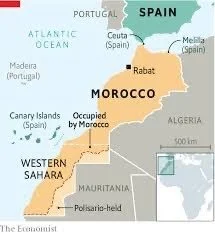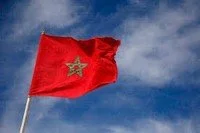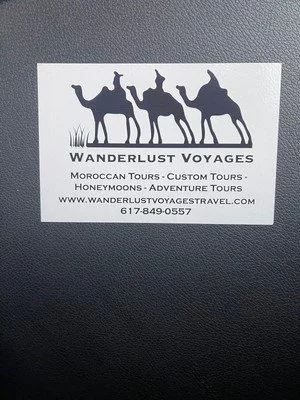Chapter One: Casablanca and Fes
"Of All The Gin Joints In All The Towns In All The World, He Walks Into Mine."
11.27.2021 - 11.27.2021 60 °F
View Morocco + Uganda + Rwanda on paulej4's travel map.
The Kingdom of Morocco is to Africa what Washington state is to the U.S.: the northwestern most point, much closer to Portugal than to the remainder of the 54 (or thereabouts) African nations. Note: Africa hosts 27% of the globe’s independent states.
The Mediterranean Sea is to the north, the Atlantic Ocean to the west, Algeria to the east and a disputed region of the Western Sahara Desert to the South. Mostly Islamic, the 37 million souls who live here trace their ancestry to the eighth century under Idris the Elder, a Berber, and grandson of the Islamic prophet, Muhammad.
Since Portugal (along with dear friends Allan and Nancy) is only eight miles north across the waters of the Strait of Gibraltar, the front door to the Mediterranean Sea, the entire world recognized the geographic importance of this place and sought to control it. It wasn’t until 1912 that Morocco was divided into Spanish and French protectorates with the City of Tangier anchoring an “international zone.” Independence finally came in 1956 (I was in the third grade). Even today, there is disputed territory to the south with the incumbent sporadic violence that always accompanies such things.
King Mohammed VI rules today (even though there is a two chamber Parliament) by decreeing “dahirs,” which are virtual laws. Should he wish to, the King can dissolve Parliament. Watch the movie ‘Casablanca’ and read of both discrimination against Jews (the apex of which was during World War II) and the existence of slavery here (until 1925) and the romance of the place, albeit decades later, is tainted. An interesting aside: most slaves here were white Europeans.
The climate here is what you would find in southern California. There are forests to the north, mountain ranges and deserts to the east and south. Once home to lions (the last shot and killed in 1922), bears and leopards (now extinct) and even crocodiles (also gone), Morocco is home to the cities of Casablanca and Marrakech but I have seen many cities. It is the desert that beckons me.
The other reason—much more practical—is that Casablanca was the easiest one-stop flight path from the U.S. to the Republic of Congo and the silverback gorillas with whom I wish to commune. But then, my Congo stop was canceled when they failed to reopen trekking camps post COVID. The Royal Air Maroc ticket already purchased, a stopover allowing a desert trek made more sense to me than a simple overnight to explore a casbah or marketplace. So here I am for a week.
It is a good thing that B is not with me on this trip. Morocco bans unmarried couples from sharing a hotel room. If caught, under Article 490 of the penal code, both sides on an unmarried couple are subject to jail terms of up to a year. Each week, police check hotel records and, as a result, one requirement at reception is to show verification of marriage certificates. I thought that sounded like “fake news” until I read it in the November 13th edition of The Economist. Rif mountain hotelier Meryem Zniber is quoted as saying, “I could fill my hotel 100% if only they’d lift the law.” By the end of June, tourism revenue here dropped by almost 60% but that’s due to COVID, not cohabitation.
About 37,000,000 people live in Morocco. National Geographic reports that there are 3,000,000 stray dogs here. A TNR (Trap-Neuter-Release) program is underway as an alternative to “killing dogs en masse” which, according to Morocco World News, has proven to be ineffective.
The in-country logistics of this trip were as difficult as I have encountered anywhere in the world. No “tour” offered what I needed or wanted. I had to arrange something entirely personal. The internet yielded KimKim, an agency that tolerated my desire to spend as much time as possible on sand with as little time in a vehicle as could be arranged.
They work through Wanderlust Voyages (www.wanderlustvoyagestravel.com) You can reach my "arranger" Megan Lower, at info@wanderlustvoyagestravel.com. Even so there are drives of seven and eight hours to get me where I want to go: a tented camp in the dunes of the Sahara, a desert which encompasses over 3.5 million square miles of hotness extending across 11 countries, third in size to the cold deserts of the northern Arctic and Antarctica, both of which were destinations I visited just before COVID tied me down. Full disclosure: I have twice visited the eastern end of this desert in Egypt but that was long ago.
Landing in Casablanca around ten in the morning local time, I was not met by Omar, who I was told would be my driver, outside the airport. After a short time of confusion, I called another number I had been given and Ibrahim and I met.
It was he who swept me off towards Fes, or, if you prefer, Fez. The drive takes me past farmland (wheat, alfalfa, olive groves, date palms, melons, "salad" (Ibrahim's description) and more. In many spots, forests of cedar trees line the road with cattle and goats grazing underneath There are, along the ocean as we drive north, many apartments, some new and shiny and others old and tired, both with gaggles of satellite dishes sprouting from their flat roofs. I ask Ibrahim what everyone watches on television. He answers "movies and politics."
The highway is good, limited access of two or three lanes supported by tolls, cleaned by trash picker-uppers and dotted with hitchhikers. At one point, a man walked the shoulder selling fresh fish (big ones--five pounds at least) he had caught this morning. In other spots, dozens of people sell dried fruit. Remember, this is being done along a "freeway." The day is cool, about 55 degrees, feeling colder with the brisk wind, the sky is cloudy and there was even a spot or two of very light rain along the way.
Ibrahim tells me of the decline in tourists but he had last week a group from Colorado and another of a dozen New Yorkers. He was "shocked" to find that five of them were not vaccinated--he says almost 8 of 10 Moroccans are vaccinated. Being unvaccinated here is difficult for a traveler. Upon showing my CDC vaccination card I was rushed through immigration, having previously completed a passenger locator form I found online that tells the government my whereabouts during my entire stay (along with two telephone numbers where I can be reached). The unvaccinated are required to complete PCR tests before arrival. If they test positive upon arrival, they must quarantine for a week. One would not want to come down with COVID while here. After a couple of hours, we stop for a coffee; I am not hungry after having a big breakfast on the plane after having skipped the dinner offered after takeoff to maximize my sleep. A couple of hours more of driving gets us to Fes.
The phrase "Inshallah" is often spoken as Ibrahim explains to me what we see en route: "If God wills it, it will happen." We stopped at a gas station/cafe combination for a rest room break and a coffee. Two very strong coffees, one pastry and two bottles of water cost 31 moroccan dirham and change; rounded to 40 with tip to the waiter who brought it to us after we had ordered at a counter. The official exchange rate today is 9.24 dirham to the dollar but you can't get that at the airport: it is 8.99 there. So, the stop was quite reasonable at a cost of under $5.00. Credit cards are not accepted for small charges such as this one.
My guide in Fes is Kamal; Ibrahim has known him for eight years. Kamal guides only is Fes while Ibrahim drives and guides all over the country. Ibrahim, a Berber (more about that later) comes from a family of nomads who moved from the desert when he was 17--a dozen years ago. Since then he has become fluent in English and makes his living with folks such as me. Kamal is a former teacher who boasts great knowledge of all things Fes.
The afternoon was devoted to exploring the Fes El Bali (an ancient medina which is an old walled part of a town located in North Africa) and learning of its history. This enormous 9th-century labyrinthian vehicle-free maze encompasses 9,454 alleyways. There are beautiful entry gates, one more elaborate than
the next with carved wood, ceramics, mosaics and more. If you would care to buy something--anything--you can find a vendor here to sell it to you. Leather goods? Dried fruit? Shoes? Rugs, plumbing fixtures, clothing, cows feet, a gigantic working leather tannery? It's all here but, refreshingly, it is not a high-pressure place--the type from which I normally want to flee. Here there is much smiling and greetings of "As-salaam Alaykum" meaning Peace be with you. In the U.S., we would use the one-word greeting of "Hello." The reply is "Walaykum As-salaam." My impression is that the local men who use this greeting with me find it gratifying that I use the local reply.
There are many mosques and an inordinate amount of history and art and craftsmanship here that may be unmatched in the Arab world. B will want to know this: I got 8,400 steps on my counter while there.
Ibrahim and Kamal then delivered me to my hotel: Riad Maison Bleue And Spa where I was welcomed with dates and milk while the front desk manager took my passport and handled formalities before delivering me to my suite. There, more dried fruit, bottled water, and plush furnishings let me know this was their finest accommodation. I took the three-door lift (an elevator with a door on the front, a door on the back and still another door on one side) to the restaurant around 7:30 for dinner. Upon arrival there, it is just too cold so I returned to my room and ordered room service: Tagine of Chicken. I have been trying to upload more photographs but, for some reason, I cannot. Oh, well.
Ibrahim calls for me tomorrow morning at 9:00 to continue our journey.
